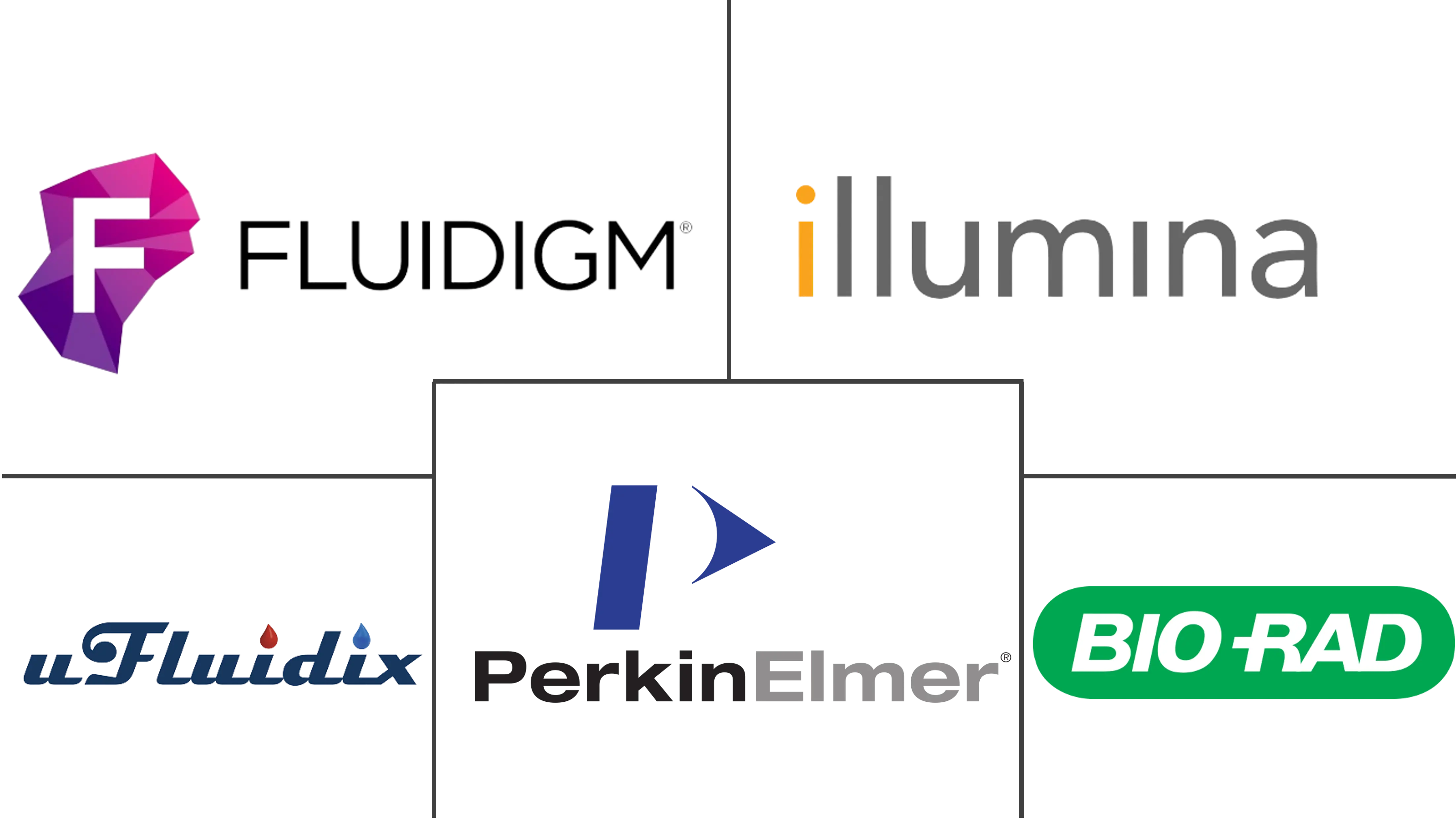Microfluidics Market Size and Share
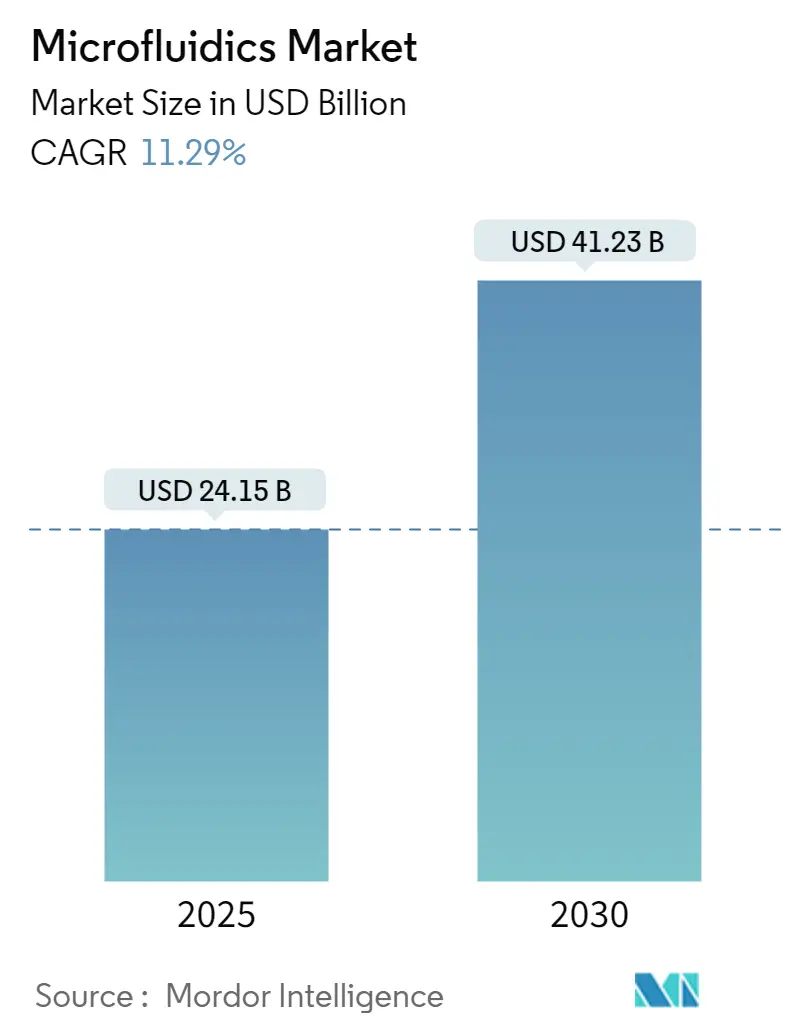
Microfluidics Market Analysis by Mordor Intelligence
The Microfluidics Market size is estimated at USD 24.15 billion in 2025, and is expected to reach USD 41.23 billion by 2030, at a CAGR of 11.29% during the forecast period (2025-2030).
Factors driving the market's expansion include a surging demand for Point of Care Diagnostics, escalating incidences of diverse diseases, quicker analysis turnaround times, and enhanced device portability.
The growing prevalence of infectious and chronic diseases, including cancer, diabetes, and cardiovascular conditions, is fueling the demand for Point of Care Diagnostics. This trend is anticipated to bolster the Microfluidics Market during the forecast period. For instance, data from the Institute for Health Metrics and Evaluation (IHME) in June 2023 highlighted that over half a billion individuals globally are living with diabetes. This condition spans across men, women, and children in every nation. Furthermore, projections indicate this figure could exceed 1.3 billion in the next three decades. Such an anticipated surge in diabetes cases underscores the urgency for innovative solutions, like novel porous microcapsules with β cells for diabetes treatment, leveraging Microfluidic Technology.
With the rise in cancer diagnoses, there's a parallel uptick in the demand for sophisticated cancer therapies, suggesting a bullish outlook for the market. For instance, data from the National Cancer Center of Japan revealed that in 2023, Japan witnessed approximately 1 million new cancer diagnoses. Given that Microfluidic Devices, including Microfluidic Chips, can simulate cancer metastasis and are adept at culturing multiple organoids from various cell types, the escalating cancer cases present a lucrative opportunity for market growth.
The fusion of Microfluidics and nanotechnology has transformed portable diagnostic devices, marking significant strides in disease detection. For instance, an article from the Royal Society of Chemistry in January 2024 emphasized that Microfluidic Devices, known for their simplicity, reliability, and sensitivity, can deliver rapid results with minimal sample volumes. These attributes make them essential for diagnosing diseases across plants, animals, and humans, suggesting a bullish outlook for the market.
Given these dynamics, the rising prevalence of chronic ailments like cancer, diabetes, and cardiovascular diseases, coupled with advancements in Microfluidic Technology, are poised to drive the Microfluidics Market's growth.
However, the integration of Microfluidic Technology with existing workflows and the low adoption in developing countries due to high prices are expected to hinder the market's growth during the forecast period.
Global Microfluidics Market Trends and Insights
The Point-of-Care Diagnostics Segment is Expected to Witness Considerable Growth During the Forecast Period
Driven by the rising prevalence of chronic diseases, a growing demand for Point of Care Diagnostics devices, and ongoing technological advancements, the Microfluidics Market is poised for substantial growth in the Point of Care Diagnostics Market segment during the forecast period. For example, Cancer Australia reported in 2023 that 162,163 cancer cases were diagnosed in Australia in 2022. This high prevalence of cancer is likely to boost the demand for Point of Care Diagnostics, fueling the market's expansion.
Technological advancements and ongoing research are enhancing Microfluidics Technology, broadening its applications, and elevating the accuracy and sensitivity of Point of Care Diagnostics. These enhancements are pivotal drivers for the adoption of Microfluidic Technology. For instance, a March 2023 study in the Biosensors Journal highlighted the extensive research on Microfluidics Technology, emphasizing its rapid operation, minimal reagent requirement (down to microliters or even nanoliters), and high integration capability, consolidating sample preparation, detection, and analysis onto a single platform.
New product launches and developments in Microfluidics for Point of Care Diagnostics by major companies are set to accelerate the segment's growth. For instance, Orange Biomed announced in September 2024 its plan to showcase a Microfluidic Chip-based A1C test at the upcoming 2024 Diabetes Technology Meeting in October. The company's innovative device, a compact, single-cell, micro-electro-mechanical A1C analyzer, is designed to be agnostic to hemoglobin variants, promising faster and more reliable results for diabetes patients. Such innovations and the introduction of Microfluidic-based Point of Care Diagnostics products are anticipated to propel the segment's growth in the coming years.
As the scope of Point of Care Diagnostics broadens, the significance of Microfluidics is set to surge, potentially paving the way for the creation of new devices.
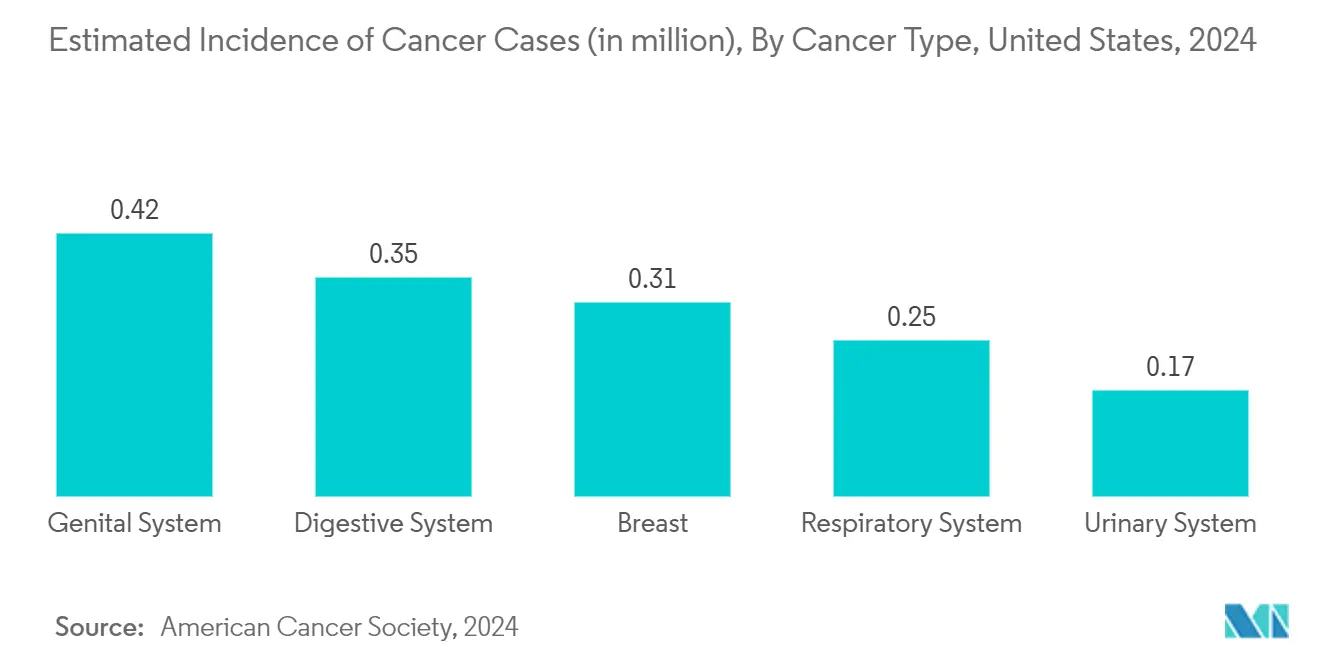
North America is Expected to Witness Significant Growth During the Forecast Period
North America is poised for significant growth in the Microfluidics Market. Factors such as a robust healthcare system, widespread adoption of innovative therapeutics, and a rising prevalence of both infectious and chronic diseases are driving this trend.
For instance, data from the International Agency for Research on Cancer indicates that Mexico had approximately 8,600 liver cancer cases in 2022, with projections suggesting a rise to 11,200 cases by 2030. Similarly, data from the Canadian Cancer Society in November 2023 highlighted that an estimated 239,100 Canadians would be diagnosed with cancer in 2023, with around 45.0% of the population expected to receive a cancer diagnosis in their lifetime. Such escalating cancer statistics in the region are anticipated to boost the demand for Microfluidic Devices, propelling the market growth.
The U.S. is set to see substantial growth in the North American Microfluidic Devices Market, driven by rising cancer cases and robust investments in the pharmaceutical sector. With a significant R&D budget, the Microfluidic Technology field is rapidly expanding in the region. Technologies like Point of Care Diagnostics, leveraging Microfluidics for applications ranging from molecular diagnostics to infectious and chronic diseases, are focusing on creating user-friendly and rapid integrated devices. For instance, projections from the American Cancer Society in January 2024 estimated over 2.0 million cancer diagnoses in the U.S. for 2024, up from 1.9 million in 2023. This escalating cancer burden is set to amplify the demand for Microfluidics.
Key market players, through their relentless innovation in advanced Microfluidics Devices, are further propelling the country's market growth. For example, in August 2023, Cytovale introduced the IntelliSep sepsis test, receiving 510(k) clearance from the U.S. FDA. This advanced test, utilizing Microfluidics, high-speed video, and sophisticated algorithms, measures white blood cells (WBCs) to indicate sepsis, delivering results in just an hour.
Given these dynamics, especially the surging prevalence of chronic diseases and the expanding application of Microfluidics, North America's Microfluidics Market is set for robust growth.
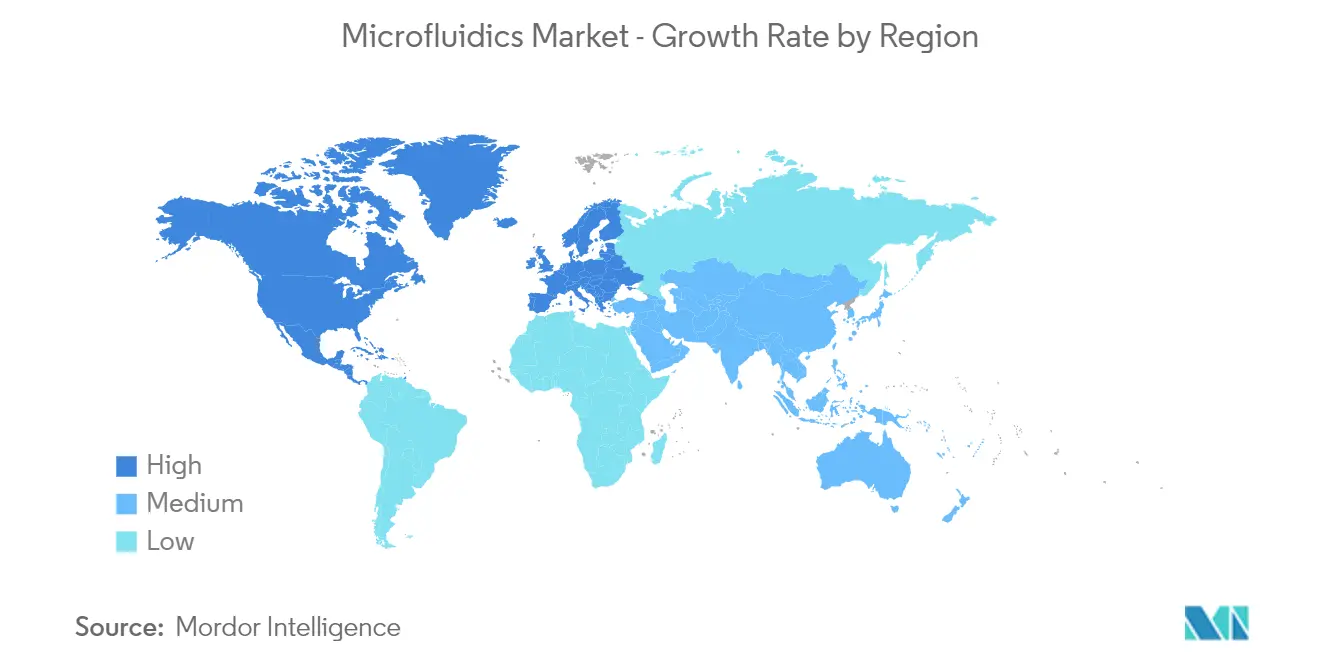
Competitive Landscape
The Microfluidics Market is highly competitive and fragmented in nature, and in terms of market share, few major players dominate the market. However, with technological advancements and product innovations, mid-size to smaller Microfluidics Companies are increasing their market presence by introducing new technologies at affordable prices. Companies like uFluidix, Bio-Rad Laboratories Inc., Fluidigm Corporation, Illumina Inc., and PerkinElmer Inc. hold a substantial market share among Microfluidic Device Companies. The key players have been involved in various strategic alliances such as acquisitions, collaborations, and launches of advanced products to secure their positions in the global Microfluidics Market.
Microfluidics Industry Leaders
-
uFluidix
-
Bio-Rad Laboratories Inc.
-
Fluidigm Corporation
-
Illumina Inc.
-
PerkinElmer, Inc.
- *Disclaimer: Major Players sorted in no particular order
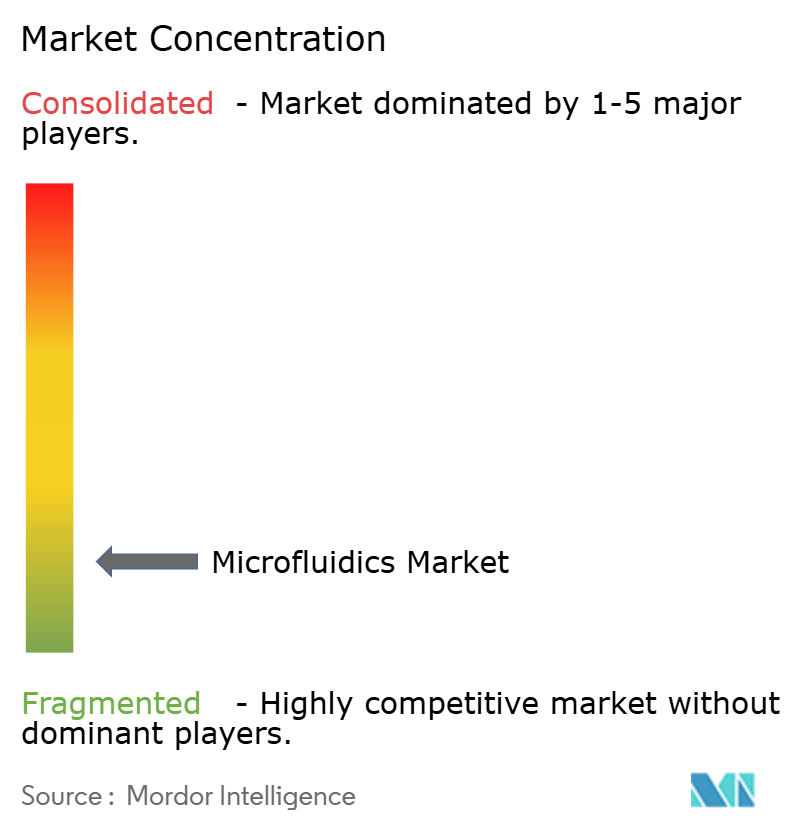
Recent Industry Developments
- May 2024: Takara Bio USA Inc. introduced the dissolvable microfluidic transduction enhancer Lenti-X Transduction Sponge, which is incorporated with in vitro lentivirus-mediated gene delivery techniques. This sponge streamlines the workflow and provides high transduction efficiency in any cell type, facilitating downstream research applications in the gene and cell therapy domain.
- May 2024: Fluidic Sciences Ltd. officially launched as a company and reintroduced the Fluidity One-M instrument, which was acquired to measure protein-protein interactions in solution. This instrument utilizes the advanced Microfluidic Diffusional Sizing (MDS) technology. With Fluidic Sciences entering the market, scientists gain a fresh avenue for superior protein biophysical characterization. This advancement propels biopharmaceutical R&D, focusing on areas like membrane protein characterization, vaccine responses, monoclonal therapeutic antibodies, and targeted protein degradation.
Global Microfluidics Market Report Scope
As per the scope of the report, microfluidics is a medical approach involving the precise control of small fluid samples for medical analysis. The sample sizes in microfluidics range from microliters to picoliters. At such low volumes, fluid transportation is governed significantly by its mass. The microfluidics market is segmented into product type, application, material, and geography. By product type, the market is segmented into microfluidic-based devices and microfluidic components. By microfluidic components, the market is segmented into microfluidic chips, micro pumps, microneedles, and other product types. By application, the market is segmented into drug delivery, point-of-care diagnostics, pharmaceutical and biotechnology research, clinical diagnostics, and other applications. By pharmaceutical and biotechnology research, the market is segmented into high-throughput screening, proteomics, genomics, cell-based assay, capillary electrophoresis, and other pharmaceutical and biotechnology research. By material, the market is segmented into polymer, silicone, glass, and other materials. By geography, the market is segmented into North America, Europe, Asia-Pacific, the Middle East and Africa, and South America. The report also covers the estimated market sizes and trends for 17 countries across major regions globally. The report offers the value (in USD) for the above segments.
| Microfluidic-based Devices | |
| Microfluidic Components | Microfluidic Chips |
| Micro Pumps | |
| Microneedles | |
| Other Components |
| Drug Delivery | |
| Point-of-care Diagnostics | |
| Pharmaceutical and Biotechnology Research | High-throughput Screening |
| Proteomics | |
| Genomics | |
| Cell-based Assay | |
| Capillary Electrophoresis | |
| Other Pharmaceutical and Biotechnology Research | |
| Clinical Diagnostics | |
| Other Applications |
| Polymer |
| Silicone |
| Glass |
| Other Materials |
| North America | United States |
| Canada | |
| Mexico | |
| Europe | France |
| United Kingdom | |
| Germany | |
| Italy | |
| Spain | |
| Rest of Europe | |
| Asia-Pacific | China |
| Japan | |
| India | |
| Australia | |
| South Korea | |
| Rest of Asia-Pacific | |
| Middle East and Africa | GCC |
| South Africa | |
| Rest of Middle East and Africa | |
| South America | Brazil |
| Argentina | |
| Rest of South America |
| By Product Type | Microfluidic-based Devices | |
| Microfluidic Components | Microfluidic Chips | |
| Micro Pumps | ||
| Microneedles | ||
| Other Components | ||
| By Application | Drug Delivery | |
| Point-of-care Diagnostics | ||
| Pharmaceutical and Biotechnology Research | High-throughput Screening | |
| Proteomics | ||
| Genomics | ||
| Cell-based Assay | ||
| Capillary Electrophoresis | ||
| Other Pharmaceutical and Biotechnology Research | ||
| Clinical Diagnostics | ||
| Other Applications | ||
| By Material | Polymer | |
| Silicone | ||
| Glass | ||
| Other Materials | ||
| By Geography | North America | United States |
| Canada | ||
| Mexico | ||
| Europe | France | |
| United Kingdom | ||
| Germany | ||
| Italy | ||
| Spain | ||
| Rest of Europe | ||
| Asia-Pacific | China | |
| Japan | ||
| India | ||
| Australia | ||
| South Korea | ||
| Rest of Asia-Pacific | ||
| Middle East and Africa | GCC | |
| South Africa | ||
| Rest of Middle East and Africa | ||
| South America | Brazil | |
| Argentina | ||
| Rest of South America | ||
Key Questions Answered in the Report
How big is the Microfluidics Market?
The Microfluidics Market size is expected to reach USD 24.15 billion in 2025 and grow at a CAGR of 11.29% to reach USD 41.23 billion by 2030.
What is the current Microfluidics Market size?
In 2025, the Microfluidics Market size is expected to reach USD 24.15 billion.
Who are the key players in Microfluidics Market?
uFluidix, Bio-Rad Laboratories Inc., Fluidigm Corporation, Illumina Inc. and PerkinElmer, Inc. are the major companies operating in the Microfluidics Market.
Which is the fastest growing region in Microfluidics Market?
Asia Pacific is estimated to grow at the highest CAGR over the forecast period (2025-2030).
Which region has the biggest share in Microfluidics Market?
In 2025, the North America accounts for the largest market share in Microfluidics Market.
What years does this Microfluidics Market cover, and what was the market size in 2024?
In 2024, the Microfluidics Market size was estimated at USD 21.42 billion. The report covers the Microfluidics Market historical market size for years: 2019, 2020, 2021, 2022, 2023 and 2024. The report also forecasts the Microfluidics Market size for years: 2025, 2026, 2027, 2028, 2029 and 2030.
Page last updated on:
Microfluidics Market Report
The global microfluidics market is experiencing remarkable growth, driven by the demand for advanced diagnostics and an uptick in chronic diseases. Innovations in lab-on-a-chip and point-of-care diagnostics are rapidly advancing healthcare by enhancing diagnostic speed, accuracy, and cost-effectiveness. The integration with PCR for swift detection and innovations in drug delivery systems underscore microfluidics' role in evolving healthcare towards more effective and controlled solutions.
North America, with significant R&D and a strong healthcare infrastructure, leads market expansion into diverse applications, making diagnostics more accessible and revolutionizing healthcare efficiency. This evolution reflects microfluidics' pivotal role in shaping future medical science and global health betterment, as detailed in industry analyses by Mordor Intelligence™.
The market size and forecasts are provided in terms of value for all the above segments. The global market is segmented by product type, application, material, and geography. The market growth is driven by demand in various sectors such as drug delivery, point-of-care diagnostics, and pharmaceutical and biotechnology research.
The industry analysis shows that microfluidics is pivotal in enhancing diagnostic speed, accuracy, and cost-effectiveness. The market forecast predicts continued growth, driven by advancements in lab-on-a-chip technologies and point-of-care diagnostics. Industry reports highlight North America's role in leading market expansion and making diagnostics more accessible.
The market overview indicates that innovations in drug delivery systems are also playing a significant role in the market's evolution. The industry outlook is positive, with the market segmentation showing diverse applications across different regions. The market leaders are focusing on R&D to further revolutionize healthcare efficiency.
The industry information provided by Mordor Intelligence™ emphasizes the importance of microfluidics in shaping future medical science. The market data supports the industry trends of increasing demand for advanced diagnostics. The market review and market predictions highlight the continuous growth and innovation in the microfluidics market.
